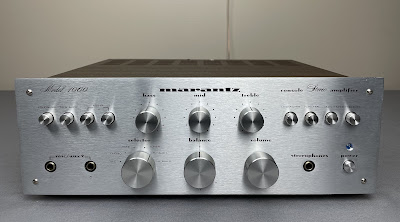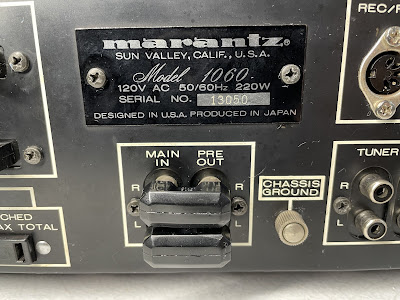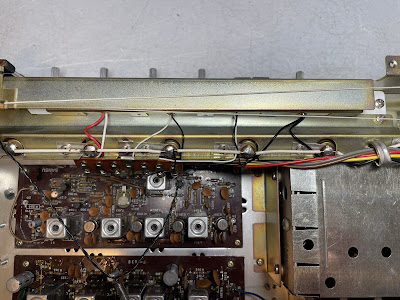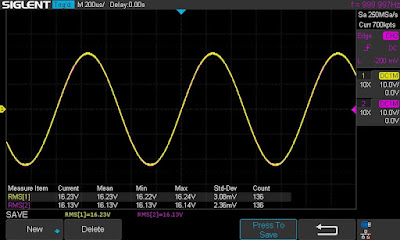Unit: Stereo Integrated Amplifier
Manufacturer: Marantz
Model: 1060
SN: 13050
Today I'm showcasing one of the most well-known, respected, and popular integrated amplifiers of the 70's. This amplifier is one of the most valuable among collectors, and the price only gets higher over time. As many of you might guess, this is a Marantz Model 1060.
Marantz 1060 was manufactured from 1971 to 1978. It produces 30 watts per channel into 8 ohms with no more than 0.5% total harmonic distortion. The optional walnut veneer cabinet for this model is WC-10.
Power Supply Board (P800)
The power supply unit provides +35V DC (pin J806) to the phono amplifier and +27V DC (pin J807) to the tone & pre-amplifier board.
Four electrolytic capacitors (C803, C804, C805, and C806) installed on this board were replaced with low impedance and high-reliability Nichicon UPW/UPM e-caps. The dried glue under each capacitor was carefully removed. The original e-caps were tested with an Atlas ESR70 capacitance meter. The capacitance of two of the four capacitors is outside the factory tolerance +/- 20%.
Test results on original capacitors removed from the power supply board:
C803: rated capacitance – 470uF, measured – 549uF, ESR – 0.01Ω, deviation: +17%
C804: rated capacitance – 100uF, measured – 161uF, ESR – 0.06Ω, deviation: +61%
C805: rated capacitance – 330uF, measured – 353uF, ESR – 0.02Ω, deviation: +7%
C806: rated capacitance – 100uF, measured – 154uF, ESR – 0.03Ω, deviation: +54%
The original semiconductor devices installed on this board were also replaced to improve the reliability of the power supply. The regulating transistor 2SC1318 installed in position H801 was replaced with a new Fairchild KSC2383YTA. Two diodes SIB-01-02 installed in positions H802 and H803 were upgraded to fast recovery rectifiers UF4005.
Power supply board - before and after
Tone & Pre-Amplifier Board (P400)
The tone & pre-amplifier board has eight low leakage capacitors (C403, C404, C407, C408, C410, C411, C412, C413), two bi-polar e-caps (C414, C415), and three aluminum electrolytic capacitors (C405, C406, C409). The original low leakage and two bi-polar e-caps were replaced with high-quality film polyester WIMA caps. The remaining aluminum e-caps were replaced with low impedance Nichicon UPW/UPM caps.
Test results on original capacitors removed from the tone & pre-amplifier board:
C403: rated capacitance – 1uF, measured – 1uF, ESR – 4.4Ω, deviation: 0%
C404: rated capacitance – 1uF, measured – 1uF, ESR – 4.2Ω, deviation: 0%
C405: rated capacitance – 10uF, measured – 10uF, ESR – 1.56Ω, deviation: 0%
C406: rated capacitance – 10uF, measured – 10uF, ESR – 1.63Ω, deviation: 0%
C407: rated capacitance – 3.3uF, measured – 3.5uF, ESR – 1.87, deviation: +6%
C408: rated capacitance – 3.3uF, measured – 3.4uF, ESR – 2.1Ω, deviation: +3%
C409: rated capacitance – 100uF, measured – 104uF, ESR – 0.09Ω, deviation: +4%
C410: rated capacitance – 3.3uF, measured – 3.5uF, ESR – 2.1Ω, deviation: +6%
C411: rated capacitance – 3.3uF, measured – 3.4uF, ESR – 2.6Ω, deviation: +3%
C412: rated capacitance – 0.47uF, measured – 0.48uF, ESR – N/A, deviation: +2%
C413: rated capacitance – 0.47uF, measured – 0.48uF, ESR – N/A, deviation: +2%
C414: rated capacitance – 1uF, measured – 1uF, ESR – 2.6Ω, deviation: 0%
C415: rated capacitance – 1uF, measured – 1uF, ESR – 2.8Ω, deviation: 0%
Four NPN transistors installed on this board are Toshiba 2SC1000. This transistor is known to get noisy over time. I replaced all 2SC1000 transistors with modern low-noise Fairchild KSC1845s. The new transistor has the same pinout as the original one.
According to the service manual, all PNP transistors in this circuit should be 2SA493. However, instead of the recommended 2SA493, the 2SA702 transistor was installed on this board. The failure modes of the 2SA702 transistor are not well documented, but they should be replaced as well. I installed new Fairchild KSA992 transistors instead of 2SA702s.
Tone & pre-amp board - before and after
Phono Amplifier Board (P900)
The phono amplifier board has four low leakage capacitors (C901, C902, C905, C906), and three aluminum electrolytic capacitors (C909, C910, C919). Two original low leakage e-caps (C901 & C902) were replaced with film polyester WIMA caps. The other two low leakage caps were replaced with modern low leakage Nichicon UKL caps. The remaining aluminum e-caps were replaced with low impedance Nichicon UPW/UPM caps.
Test results on original capacitors removed from the phono amplifier board:
C901: rated capacitance – 1uF, measured – 0.9uF, ESR – 4.2Ω, deviation: -10%
C902: rated capacitance – 1uF, measured – 1uF, ESR – 3.8Ω, deviation: 0%
C905: rated capacitance – 22uF, measured – 23uF, ESR – 0.31Ω, deviation: +5%
C906: rated capacitance – 22uF, measured – 23uF, ESR – 0.68Ω, deviation: +5%
C909: rated capacitance – 47uF, measured – 66uF, ESR – 0.32Ω, deviation: +40%
C910: rated capacitance – 47uF, measured – 57uF, ESR – 0.35Ω, deviation: +21%
C919: rated capacitance – 100uF, measured – 138uF, ESR – 0.12Ω, deviation: +38%
Also, this board utilizes two types of notoriously bad transistors: 2SC1000 and 2SC458. Both transistors are well-known troublemakers and get noisy over time. I replaced them with modern low-noise Fairchild KSC1845s. Two transistors H905 and H906 were gain matched within 1%. Watch the pinout on the replacement transistors. The original 2SC1000 transistor has the same pinout as a new KSC1845, i.e. ECB. However, the 2SC458 transistor has a BCE pinout.
Phono amplifier board - before and after
The power amplifier board in this unit has been previously serviced by someone. And I must say that this work was done poorly. The low-quality electrolytic capacitors were installed in several positions. The soldering quality is quite poor and messy. The lead of one resistor was bent but not soldered to the PCB. Everything must be redone.
Bad soldering, one lead was not soldered to the PCB
The power amplifier board has four low leakage e-caps (C701, C702, C711, C712) installed in the signal path, and eight aluminum electrolytic capacitors (C703, C704, C707 thru C710, C717, C718). I replaced two original low leakage e-caps C701 and C702 with film polyester WIMA caps. The other two low leakage e-caps (C711 and C712) were replaced with modern low leakage Nichicon UKL caps. The remaining aluminum e-caps were replaced with low impedance Nichicon UPW/UPM caps.
I tested all e-caps removed from this board with an Atlas ESR70 capacitance meter and the results are below. The measured capacitance of C709 is only 13uF (deviation from the rated capacitance is 72%!). Another e-cap C718 failed the test (open circuit/low capacitance).
Test results on original capacitors removed from the power amplifier board:
C701: rated capacitance – 1uF, measured – 1uF, ESR – 4.1Ω, deviation: 0%
C702: rated capacitance – 1uF, measured – 0.9uF, ESR – 4.3Ω, deviation: -10%
C703: rated capacitance – 47uF, measured – 45uF, ESR – 0.52Ω, deviation: -4%
C704: rated capacitance – 47uF, measured – 55uF, ESR – 0.1Ω, deviation: +17%
C707: rated capacitance – 47uF, measured – 48uF, ESR – 0.32Ω, deviation: +2%
C708: rated capacitance – 47uF, measured – 57uF, ESR – 0.28Ω, deviation: +21%
C709: rated capacitance – 47uF, measured – 13uF, ESR – 0.85Ω, deviation: -72%
C710: rated capacitance – 47uF, measured – 46uF, ESR – 0.26Ω, deviation: -2%
C711: rated capacitance – 10uF, measured – 11uF, ESR – 1.43Ω, deviation: +10%
C712: rated capacitance – 10uF, measured – 11uF, ESR – 1.16Ω, deviation: +10%
C717: rated capacitance – 22uF, measured – 22uF, ESR – 2.5Ω, deviation: 0%
C718: rated capacitance – 22uF, measured – open circuit/low capacitance
Both original pre-driver transistors (H701 & H702) were upgraded to the new Fairchild KSC945CYTA.
The original trimming resistors R723/R724 (100 kΩ, clipping level), and R729/R730 (470 Ω, Bias) were replaced with new Bourns potentiometers.
Power amplifier board - before and after
Power Transistors
Two power transistors from the left channel in this unit were previously replaced with Sylvania ECG280. The other two transistors from the right channel are original Marantz 2SC897D. I tested the power transistors with Atlas DCA55 semiconductor analyzer and all transistors are still good. However, I am not familiar with Sylvania power transistors and have doubts about their performance/quality. So, I decided to replace all four transistors with new ON Semiconductor MJ21194G's. The new transistors are specifically designed for high-power audio output and have excellent gain linearity. In addition, the total harmonic distortion measured on two matched pairs of MJ21194G transistors can be as low as 0.08% according to the datasheet. So, it is a perfect choice as a substitution transistor for the original 2SC897D. The new Mica pads and fresh thermal compound were applied between each power transistor and heat sink. The fresh thermal compound was also applied to the thermal tracking diodes H005 and H006.
Old power transistors (Sylvania ECG280 and Marantz 2SC897D)
New power transistors are installed (ON Semiconductor MJ21194G)
Missing Pre-OUT/Main IN terminal
For some reason, the Pre-OUT/Main IN terminal as well as both jumper plugs were missing in this unit. Somebody who serviced this unit before removed it from the rear panel, cut out the wires, and bypassed the Pre-OUT/Main IN terminal directly to the power amplifier board. What a stupid solution! It looks ugly and disrespectful to this beautiful amplifier.
I installed a new terminal from the old stock and rewired all connections according to the schematic. Two resistors (R007 & R008, 220 kΩ, 1/4 W) were also soldered between the input and ground following the schematic diagram.
Missing Pre-OUT/Main IN terminal and jumper plugs
New Pre-OUT/Main IN terminal and jumper plugs are installed
Power Amplifier Adjustment
The Bias is measured across the emitter resistors R747 (jacks 713 & 715) and R748 (jacks 714 & 716). It was adjusted to ~7.5mV on each channel according to the service manual with trimming resistors R729 and R730.
The other two trimming resistors (R723 & R724) are used to adjust an equal and symmetrical clipping of the 1 kHz sine-wave signal.
Bias on the left and right channels after restoration
Output Power Test
The final output power test was performed at the end of my restoration. The amplifier was loaded with a low inductance 8Ω/100W dummy resistor for each channel. The oscilloscope was connected across the speaker terminals and a sine-wave signal of 1kHz was applied to the AUX jacks. The output sine-wave signal was perfectly symmetrical on both channels with no clipping up to 16.54 VRMS (left channel) and 16.48 VRMS (right channel). It corresponds to the output power of 34.2W on the left channel and 33.9W on the right channel.
Output power test
As usual, all the knobs and the face plate were gently cleaned in warm water with dish soap. All controls have been cleaned with DeoxIT 5% contact cleaner and lubricated with DeoxIT FaderLube 5% spray.
The final result can be seen in the photos below. The amplifier looks brand new again and sounds awesome. Please watch a short demo video at the end of this post. Thank you for reading.
Marantz 1060 - before and after restoration, inside view


_before%20servicing.jpg)
_after%20servicing.jpg)
_before%20servicing.jpg)
_after%20servicing.jpg)
_before%20servicing.jpg)
_after%20servicing.jpg)
_bad%20soldering,%20one%20lead%20was%20not%20soldered.jpg)
_before%20servicing.jpg)
_after%20servicing.jpg)












_before%20servicing.jpg)
_after%20servicing.jpg)
_before%20servicing.jpg)
_after%20servicing.jpg)
_before%20servicing.jpg)
_after%20servicing.jpg)
_before%20servicing.jpg)
_after%20servicing.jpg)
_before%20servicing.jpg)
_after%20servicing.jpg)
_before%20servicing.jpg)
_foil%20side_before%20servicing.jpg)
_after%20servicing.jpg)
_foil%20side_after%20servicing.jpg)






